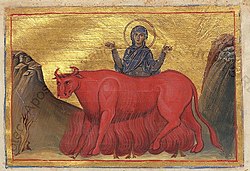Pelagia of Tarsus
| Saint Pelagia of Tarsus | |
|---|---|

Miniature from the Menologion of Basil II
|
|
| Died | reputedly in the early 4th century |
| Venerated in |
Eastern Orthodox Church Roman Catholic Church |
| Feast | October 8 (Greek Orthodox) May 4 (Roman Catholic) |
Pelagia (Greek: Πελαγία; d. early 4th century), distinguished as Pelagia of Tarsus and Pelagia the Martyr (Πελαγία ἡ Μάρτυς, Pelagía ē Mártys), is a legendary Christian saint and martyr who lived in Tarsus in Cilicia (southeastern Asia Minor) during the reign of Roman emperor Diocletian. Originally, her feast day was celebrated on October 8, in common with SS Pelagia the Virgin & Pelagia the Harlot, both of Antioch and one or both of whom her story is probably modeled after. In the Roman Catholic Church, the feast was eventually moved to May 4.
According to tradition, Diocletian's son, the heir to the throne, fell in love with her and wanted to marry Pelagia. She replied that she could not, because she had sworn to preserve her virginity and was wedded to Christ. In his sorrow, Diocletian's son killed himself. Pelagia was sent to Rome by her pagan mother, where Diocletian asked her to become his wife. She refused, calling the emperor insane. She was then burnt to death, and her flesh melted and smells of myrrh pervaded throughout Rome. By some versions, she was burned within a Brazen bull. The story concludes by relating that the pagans sent four lions to surround her bones, but instead they protected her bones from vultures and crows until a Christian bishop could recover them.
...
Wikipedia
